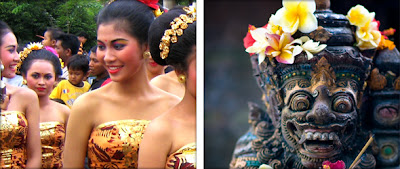5 Uniquely Indonesian Festivals
By Nikolas Tjhin
Indonesia is often referred to as the sleeping giant of Southeast Asia, and rightly so. With more than 18,000 islands in its archipelago, there is an amazing diversity of what to see and do while on holiday here.
Modernization has seen development (some would say over-development) wash over Jakarta, while Bali’s tourism continues to enjoy a gradual revival after the horrible 2002 bombing. There is also the mountains of Bromo and the mythical Borobudur for those looking for an off-the-beaten path attractions, as well as more than 6,000 inhabited islands.
Not surprisingly, Indonesia boasts various festivals that are unique to their culture, reflecting the assorted races and traditions in different parts of the archipelago. You’ll find this diversity in the following list of 6 Uniquely Indonesian Festivals, ranging from celebrations of art, batik, to dances and ceremonies. If possible, you’ll do well to catch any one of these festivals during your visit to Indonesia!
Tuping Karnaval and Mount Krakatau
Krakatoa Festival
An annual festival held in Lampung, the Krakatoa Festival is held to celebrate the volcanic island by the same name, Krakatoa. This famed volcano erupted violently as far back as 1927, some of which has resulted in newer smaller islands, named Anak Krakatoa (Child of Krakatoa).
During the festival, one can enjoy various performances such as the Tuping Karnaval (Lampung Mask Carnival), elephant procession as well as assorted dance performances from Lampung and its surrounding townships. The finale of the event is a trip to the volcanic island itself, still active but sleeping dormant for the time being!
Bali Art Festival
Bali Art Festival
One of the largest annual celebration of art and culture in Indonesia, the Bali Art Festival is always, always crowded. It is a full month of daily performances, arts exhibitions and other related cultural activities during which the whole of Bali comes along to present its offering of dance, music and beauty.
This famed celebration offers various performances such as forgotten village dances, trances from remote parts of Bali, food, offerings and handicrafts, as well as new creations from Denpasar’s dance schools and contemporary choreography from national and international artists.
Solo Batik Festival
Solo Batik Carnival
From a long time ago, the tradition of Batik has always had very strong roots in Solo. This central Java town has even taken Batik as its icon and identity, an apt portrayal of a town known for its royal beauty and calm demeanor. The Solo Batik Carnival was held to reinforce this tradition, and further promote Batik in international and national scale.
The event is a combination of ceremonies, fashion shows and carnival, all of which using Batik as a constant theme throughout. There will also be a bazaar offering various Batiks and souvenirs unique to Solo for your perusal.
Solo International Ethnic Music Festival
Another recent offering in Solo is the Solo International Ethnic Music (SIEM) Festival, which focuses on performances and celebration of ethnic music. The event is a unique platform for collaboration between ethnic and modern music, local and international artists. The long list of performers includes artists from all over the archipelago, such as Minang, Riau, Yogyakarta, Surabaya, Papua, Kalimantan, and even foreign imports from Japan, Australia, India, New Zealand and many others.
The gamelan, and Yogyakarta's Sekaten
Gerebeg Mulud
In Javanese, gerebeg means a crowd of people and mulud refers to one of the month in the Javanese calendar. This event, also known as Sekaten, is to celebrate the birthday of the Holy Prophet Muhammad. It is a day-long procession which sees two of the sacred gamelan (a Javanese musical instrument) transported towards the Mesjid Agung (Holy Mosque).
During the night there will be a street-side market in the north side of town to add to the revelries, a great spot to try various Javanese and Yogyakartan foods and hunt for souvenirs.
Papua Festival
Lembah Baliem Festival
This uniquely Papuan festival traces its root in the belief held by the various local tribe that war is not only a conflict of power and interest, but also a symbol of fertility and prosperity. Since 20 years ago however, the local government has enforced peace between the warring tribes to prevent long-lasting vengeance and loss of life. So instead, the Lembah Baliem Festival was held to replace the war between the tribes.
As you can guess, the main event is the mock-war between the local tribes. Imagine more than 20 different tribes each with 30 to 50 people clad in traditional clothing, spears, bow and arrows and parang! There are also other performances and attractions, such as local traditional games, dance performances, as well as a cookout showcasing the local cuisine.
By : Beliani Z. I.







